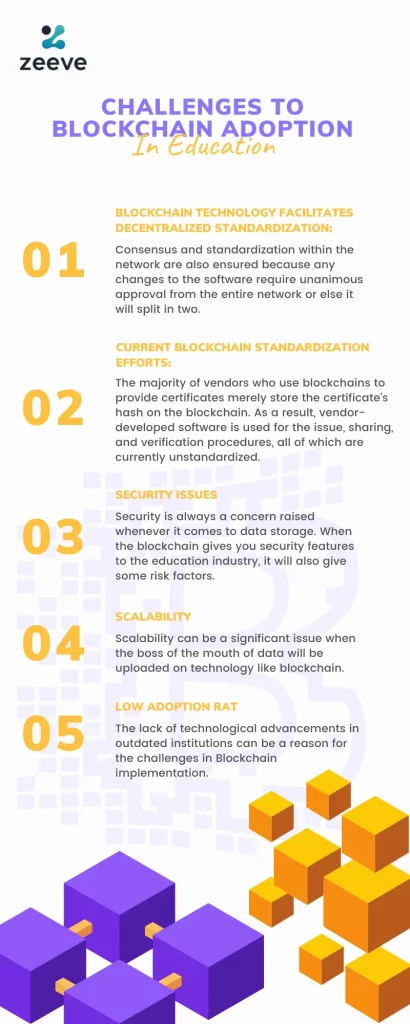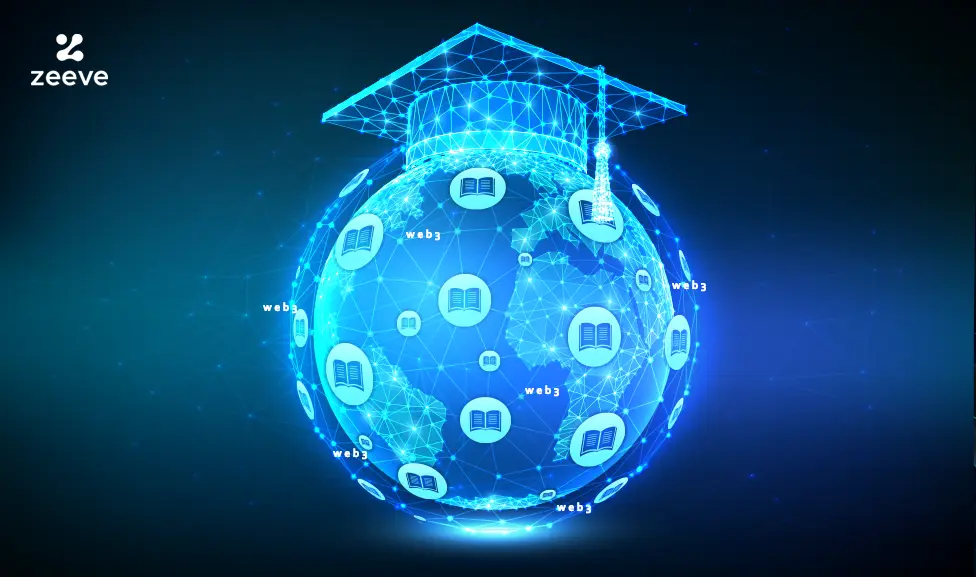The Indian education sector is also witnessing changes after the emergence of Web3 technology. Till now, we are witnessing Web 2.0, where students can get education from online education portals. However, in Web 3.0, there will be decentralization of data.
The Web3 community is ushering in a new era during which Internet users can have more control over the information that is collected about them. Web3 technology is employed in every industry nowadays, from art, finance, hospitality, and banking. The shift is mainly to create a decentralized system for everyone, from the creators to the users.This change is disrupting many different industries, including the education sector, and will have far-reaching effects for young people. Web3 certainly holds the key to revolutionize learning and educate the next generation of students most effectively, if adopted by masses and leveraged properly.
The projections made in the US-India Strategic Partnership Forum suggests Web3 to add 1.1 trillion to India’s GDP by 2032. India is at the forefront of IT, and Indian youth can make Web3 adoption stronger. Our country will soon become the flag-bearer of global policies related to Web3.
Increased thrust on adoption of web 3 in the education system of India is sure to help the country make rapid strides. Now, learners will get skill-based internships, collaborative projects, and better courses. In addition, the students will get NFTs, awards, certificates, experience letters, and much more on the blockchain network. Moreover, with Web3, all the information will remain secure on the network, and no sole entity will be the custodian of all the credentials.
Education System Evolution
The educational system is continually experiencing ongoing change, with the first phase addressing universities and schools moving information in offline mode. This was followed by an era of online platforms such as Khan Academy, Udemy, Coursera among others that make some content available to learners worldwide but also provide a level or credentialing through peer collaboration. We’re still living within the “second phase” at this point while transitioning into what will come as the next generation education system!
The ways that we learn are changing. We are no longer confined to brick-and-mortar classrooms or the choice of the college calendar. Now, learning is happening virtually anywhere at any time – not just confined to four walls of a classroom or an educational institution, thanks to advances in technology. Thanks to technology, we have contemporary access to resources and ideas. Entering the digital age means more access to these resources. Instead of depending on central sources, we’ll have the capability to tap into the collective wisdom of the mass. Education in the future is decentralized, collaborative.
Great changes to come from advent of Web3 in our education system
India aims to achieve a 100% Gross Enrolment Ratio by 2030. This will be possible by decentralizing education where the content development, evaluation, attendance and results will be integrated into one platform.
The tracking of academics, fees, extra-curricular activities, and elective subjects will be saved on a tamper-proof record. Also, on Web3, it will be easier to maintain faculty performance easily on the decentralized system. In recent years, Edtech industries have been promoting flexible and independent learning from anywhere and mobile learning has only fueled the growth of independent learning. This can be further made possible by embracing Web3 in education.
According to Edapp, a leader in eLearning and mobile microlearning platforms, “Mobile learning is the fastest growing market in education, with an average growth rate of 20% year-on -year. By 2020 it has been projected to be worth $22.4 billion globally and by 2027 this figure could reach up to $80 billion!”
To sum it up, the web 3.0 technology has various benefits for the education sector. Some of these benefits include:
– Increased accessibility to learning resources and materials: With web 3.0, educational institutions can make their content more accessible to a wider audience by using blockchain technology. This allows students in remote areas or who are not able to travel to access important curricular materials, for example.
– Improved security and data privacy: Because blockchain technology is decentralized, it provides a secure platform for transmitting and storing data. This means that educational institutions can protect student data from abuse and unauthorized access, without relying on third parties such as insurers or landlords.
– Reduced costs: By using blockchain technology, educational institutions can reduce their costs associated with administering courses and other administrative tasks. For instance, they can eliminate the need for expensive software licenses or third-party service providers.
Decentralization in education
In a Web 3 world, credentials will no longer be maintained by one institution. The ability to maintain proof of work and history on blockchains means that learners can create their own portfolio which includes collaborative projects with peers or internships during school terms while also having courses from universities under contract for additional learning opportunities outside the classroom setting as well!
Learners will get skill-based internships, collaborative projects, and better courses. In addition, the students will get NFTs, awards, certificates, experience letters, and much more on the blockchain network. Moreover, with Web3, all the information will remain secure on the network, and no sole entity will be the custodian of all the credentials.
A number of prestigious universities like MIT and IIT Kanpur have already introduced blockchain storage and digital virtual degrees for recipients.
Web3 can enhance teaching-learning experience
DAOs as University substitutes
MOOCs (Massive Open Online Courses) have begun to internalize power and value from other legacy systems like schools and universities, and its decentralized autonomous organizations (DAOs) are redefining a new era of social and financial incentive models. The transition from legacy systems to web 3 powered education systems is only a matter of time.
The Web3 technology will be helpful in the following ways:
- With Scalable Vector Graphics (SVG) integration, there will be an immersive 3D internet environment. In addition, there will be a large amount of content for Virtual Encyclopedia that can be created with rich multimedia to support the context.
- To promote effective learning in primary schools, institutes can include multi-sensory effects such as animation and virtual reality (VR).
- With Web3 Semantic web, the current search engines have become the “intelligent search engines” along with organized data. Therefore, less time will go into searching for educational content.
- Raising funds by educational institutions will also be easier with the adoption of Web3, as its feature decentralization would be helpful.
Moreover, with digitisation schemes, access to the Internet has become easier for a limited fee. As a result, studying costs will be reduced as knowledge will be easily accessible on mobile devices. The illiteracy rate will also improve drastically with easy access to education in a structured format.
Lastly, various resources will be there to cross-check the authenticity of any answer. In addition, students will be part of the educational content creation; thus, the educational content creation will not only be limited to the teachers.

How Web3 will address the problems of current education system in India
Web3, a decentralized platform that runs on blockchain technology, could be the solution to some of the problems faced by the present education system in India (primary and higher education). The problem with the current system is that it is based on outdated technology and has not been able to keep up with the changing times. There is a brain drain as well as a lack of funds and resources, which limits the ability of schools to provide quality education. Web3 could help to address these issues by providing a more efficient and user-friendly platform for students and educators.
With Web 3, students will have access to information from anywhere at any time; this means they can create their own content in addition to learning how to do it themselves! There will be reduced expenses on the teacher’s end because now there won’t be paperwork or books required for assignments–everything has been digitized so you’ll never lose your work again.
There are certain issues such as censorship or developer-related issues. Further, who will tag the chunks of information on the internet? We can eradicate these issues by framing policies and setting up firm targets.
The government is ready to adopt Web3 and Blockchain to provide immense opportunities to every citizen. In August 2022, Jayesh Ranjan, Principal Secretary, Industry & Commerce and IT, Government of Telangana, launched the — India Blockchain Forum. To increase awareness and collaboration among industries, academia, and regulators and take a holistic approach to adopt Web3 in the Indian Education system.
The idea is to collaborate with global research institutions to build a strong higher education community in India. With better education and opportunities available in the country, there will be less brain drain, and the youth will be compassionate to empower the Indian economy.
India well positioned to embrace Web3
In the upcoming years, countries with a strong and thriving technology sector will hold an advantage. This is especially true for countries like India, which are quickly embracing the world of Web3 – a new frontier in blockchain technology. India has a wealth of talented developers, who are well-versed in coding and cryptography. In addition, the country has a large population of software engineers and entrepreneurs. All of these factors make India well-positioned to embrace Web3 and become a leading player in this new field. In a Web3 world, education will be more accessible and effective than ever before as barriers to entry for higher-learning continue falling!
Zeeve helping educational institutions for web2 integration
Are you an educational institution or an academic company or startup focused on becoming big in the educational sector? If so then take your next steps towards integration of web3 into your organization and decentralize education, make it more collaborative, personalized, efficient, and also equitable. Connect with the experts at the leading blockchain infrastructure management platform – https://www.zeeve.io/. We will deploy blockchain infrastructure at a faster pace without compromising on cost and security.
We provide enterprise-grade blockchain solutions that can be deployed with ease. Educational startups can get great help from our professionals in building, deploying and managing decentralized applications(dApps). We feature robust APIs to build DApps for many use cases across industries. So let’s connect to understand more about your organization. Feel free to contact us on Twitter and Telegram. For more details, schedule a free call with our Blockchain specialist.






















